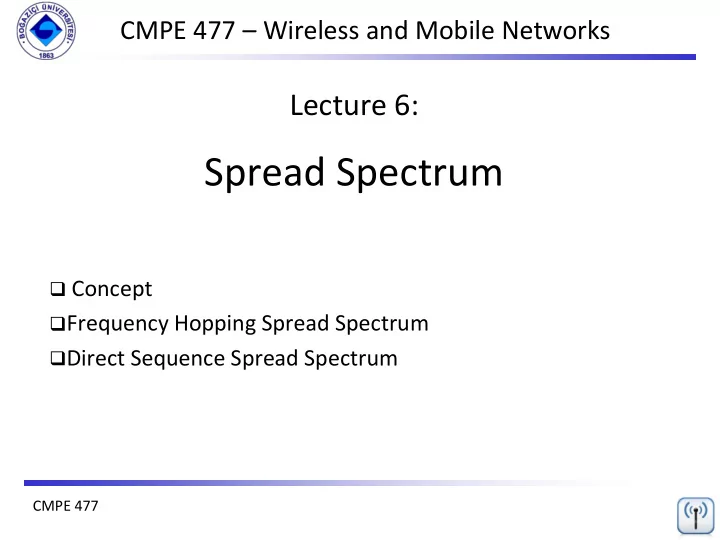

CMPE 477 – Wireless and Mobile Networks Lecture 6: Spread Spectrum Concept Frequency Hopping Spread Spectrum Direct Sequence Spread Spectrum CMPE 477
Spread Spectrum Problem of radio transmission: frequency dependent fading can wipe out narrow band signals for duration of the interference, i.e., narrowband interference Solution: spread the narrow band signal into a broad band signal using a special code protection against narrow band interference interference signal power spread power signal spread detection at interference receiver f f
Spreading and Despreading dP/df dP/df user signal broadband interference i) ii) narrowband interference f f sender dP/df dP/df dP/df iii) iv) v) f f f receiver
Spreading and frequency selective fading channel quality narrowband channels 2 1 5 6 3 4 frequency narrow band guard space signal channel quality 2 spread spectrum channels 2 2 2 2 1 frequency spread spectrum
Spread Spectrum Input is fed into a channel encoder Produces analog signal with narrow bandwidth Signal is further modulated using sequence of digits Spreading code or spreading sequence Generated by pseudonoise, or pseudo-random number generator Effect of modulation is to increase bandwidth of signal to be transmitted On receiving end, digit sequence is used to demodulate the spread spectrum signal Signal is fed into a channel decoder to recover data
Spread Spectrum What can be gained from apparent waste of spectrum? Immunity from various kinds of noise and multipath distortion Can be used for hiding and encrypting signals Several users can independently use the same higher bandwidth with very little interference
Direct Sequence Spread Spectrum (DSSS) Each bit in original signal is represented by multiple bits in the transmitted signal Spreading code spreads signal across a wider frequency band Spread is in direct proportion to number of bits used One technique combines digital information stream with the spreading code bit stream (chipping sequence) using exclusive-OR
An example t b Spreading factor : s = t b /t c w s = s.w (w: original bandwidth) user data Advantages 0 1 XOR reduces frequency selective fading t c in cellular networks chipping base stations can use the sequence same frequency range 0 1 1 0 1 0 1 0 1 1 0 1 0 1 = Disadvantages precise power control necessary resulting signal 0 1 1 0 1 0 1 1 0 0 1 0 1 0 t b : bit period t c : chip period
DSSS Transmitter and Receiver spread spectrum transmit user data signal signal X modulator chipping radio sequence carrier transmitter What if the multipath propagation? Rake receiver correlator lowpass sampled products filtered sums received data signal signal demodulator X integrator decision radio chipping carrier sequence Integrator : Addition of products Decision : Whether it is 1 or 0 receiver acc. to the product
Another Example
Frequency Hoping Spread Spectrum (FHSS) Signal is broadcast over seemingly random series of radio frequencies A number of channels allocated for the FH signal Width of each channel corresponds to bandwidth of input signal Signal hops from frequency to frequency at fixed intervals Transmitter operates in one channel at a time Bits are transmitted using some encoding scheme At each successive interval, a new carrier frequency is selected
Frequency Hoping Spread Spectrum Channel sequence dictated by spreading code Receiver, hopping between frequencies in synchronization with transmitter, picks up message Advantages Eavesdroppers hear only unintelligible blips Attempts to jam signal on one frequency succeed only at knocking out a few bits
Frequency Hoping Spread Spectrum
FHSS Using MFSK MFSK signal is translated to a new frequency every T c (dwell-time) seconds by modulating the MFSK signal with the FHSS carrier signal For data rate of R: duration of a bit: T = 1/ R seconds duration of signal element: T s = LT seconds (L: number of signal elements) T c T s - slow-frequency-hop spread spectrum T c < T s - fast-frequency-hop spread spectrum (Better at overcoming frequency selective fading)
FHSS Using MFSK
FHSS Performance Considerations Advantages frequency selective fading and interference limited to short period Results in a system that is quite resistant to jamming, Jammer must jam all frequencies simple implementation uses only small portion of spectrum at any time Disadvantages not as robust as DSSS (DSSS is more robust to fading and multi-path effects) simpler to detect Large number of frequencies used
Where are they used? FHSS • Bluetooth DSSS • 802.11b • The United States GPS and European Galileo satellite navigation systems • Cordless phones operating in the 900 MHz, 2.4 GHz and 5.8 GHz bands • IEEE 802.15.4
Recommend
More recommend